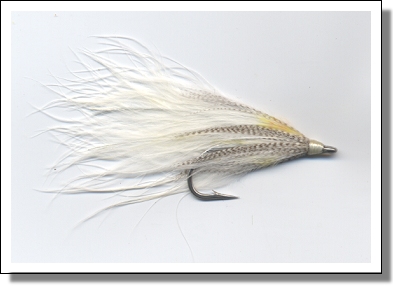 I think if Jack were still alive he would be making a lot of tying videos. It was something we talked about and I wish we’d done more of it. I was reminded of this today when I was talking on the phone with a tyer from Wisconsin, describing one of Jack’s signature patterns, the Soft Hackle Streamer. It’s a fly that is at once very simple and amazingly effective. It can and has caught just about everything, from bonefish to catfish to tarpon to carp.
I think if Jack were still alive he would be making a lot of tying videos. It was something we talked about and I wish we’d done more of it. I was reminded of this today when I was talking on the phone with a tyer from Wisconsin, describing one of Jack’s signature patterns, the Soft Hackle Streamer. It’s a fly that is at once very simple and amazingly effective. It can and has caught just about everything, from bonefish to catfish to tarpon to carp.
In the course of our conversation I was describing the blood marabou you need to tie the pattern correctly. The tyer hadn’t heard of blood marabou and it took me a little to explain how it differs from standard quill. When I got off the phone I wondered if anyone had made a video of its tying steps. So I did a quick internet search. And the answer was yes. Several.
Now one of the great things about the Soft Hackle Streamer is how adaptable to change it is. So not surprisingly, of the videos I found, no two tied it exactly the same. And none of them tied it quite in the way Jack did (granting that Jack himself tied it in a variety of styles).
The video below, from Joe Cornwall of Ohio, is very good (no comment on the opening music, tho 😉 ). If you’ve never tied the fly before, it’s well worth a watch, as is one by Jim Misiura. Joe does a good job emphasizing some of the things critical to understanding the pattern: its ‘breathability”; the importance of using blood marabou; the method of winding the marabou as hackle; and the importance of combing out the fly (Jack used a fly or eyelash comb rather than a tooth brush).
There also are a few differences worth noting between how Jack tied the fly and how Joe ties it:
- Jack did not to my knowledge ever tie the pattern on short-shank hooks, usually using a Mustad 9671 or equivalent. (When tying Soft Hackle Streamers for tarpon, he used long-shank hooks, tying the fly on the rear third of the shank and leaving the front two-thirds bare. This protects it some from the tarpon’s sandpaper mouth.)
- Jack tied the pattern with a collar, usually of folded wood duck flank. (On his New Wave Soft Hackle Streamer he used the lower, downy end of a grizzly saddle feather). He believed the collar served a very important function: it helps the head maintain a consistent shape. Specifically, it helps prevent the marabou from “jelly-fishing” forward during pauses in your retrieve.
Warning: preg_replace(): The /e modifier is no longer supported, use preg_replace_callback instead in /home1/mquigley/public_html/jackgartside.com/wordpress/wp-content/plugins/wp-comment-links.php on line 28
Warning: preg_replace(): The /e modifier is no longer supported, use preg_replace_callback instead in /home1/mquigley/public_html/jackgartside.com/wordpress/wp-content/plugins/wp-comment-links.php on line 28
Warning: preg_replace(): The /e modifier is no longer supported, use preg_replace_callback instead in /home1/mquigley/public_html/jackgartside.com/wordpress/wp-content/plugins/wp-comment-links.php on line 28
Warning: preg_replace(): The /e modifier is no longer supported, use preg_replace_callback instead in /home1/mquigley/public_html/jackgartside.com/wordpress/wp-content/plugins/wp-comment-links.php on line 28
Warning: preg_replace(): The /e modifier is no longer supported, use preg_replace_callback instead in /home1/mquigley/public_html/jackgartside.com/wordpress/wp-content/plugins/wp-comment-links.php on line 28